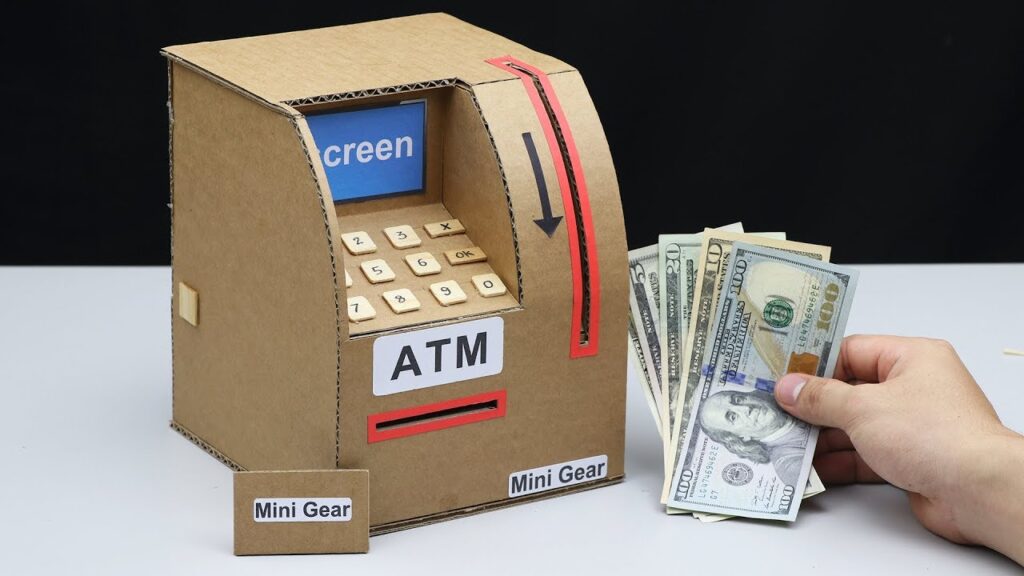
An ATM (Automated Teller Machine) is an electronic device that enables individuals to perform basic financial transactions without the need for human assistance. These machines are commonly used for withdrawing cash, but they also provide various other banking services. Below is a detailed overview of how ATMs work, their components, and the services they offer:
1. Basic Functions of an ATM:
- Cash Withdrawal: The primary function of an ATM is to allow users to withdraw cash from their bank accounts.
- Balance Inquiry: Users can check their account balance.
- Fund Transfer: ATMs allow transfers between accounts, often within the same bank, and sometimes even to different banks.
- Deposit: Many ATMs accept deposits, including cash and checks, directly into a user’s bank account.
- PIN Change: Users can change their PIN (Personal Identification Number) for added security.
- Mini-Statements: Users can print a mini-statement showing their recent transactions.
- Bill Payments: Some ATMs also allow for utility bill payments, such as for electricity, water, and others.
2. Components of an ATM:
- Card Reader: A magnetic stripe or chip reader that captures data from the user’s ATM card.
- Keypad: Allows users to enter their PIN, transaction details, and other inputs.
- Screen: Displays the ATM interface, showing instructions, prompts, and transaction details.
- Cash Dispenser: The machine part responsible for dispensing cash after a withdrawal request is processed.
- Cash Accepting Slot: In deposit-enabled ATMs, this slot is used to insert cash or checks.
- Receipt Printer: Prints receipts for transaction records, providing details like withdrawal amount, account balance, etc.
- Speaker: Some ATMs have speakers that give audible cues during the transaction process, and some provide voice assistance for visually impaired users.
- Network Connection: ATMs connect to the bank’s central computer network for authorization and transaction processing.
3. How ATMs Work:
Here’s a basic process of how an ATM operates during a transaction:
a. User Authentication:
The ATM prompts the user to insert a card, which is read by the card reader. The user then enters their PIN via the keypad. This is used to authenticate the user and grant access to the account.
b. Transaction Request:
Once authenticated, the user can select the transaction type (withdrawal, balance inquiry, etc.). If withdrawing cash, the user specifies the amount.
c. Transaction Processing:
The ATM sends the transaction details (via a secure connection) to the bank’s server. The bank server checks the user’s account for sufficient funds (in the case of a withdrawal) or validity (for other requests). If approved, the transaction proceeds.
d. Cash Dispensation:
If the transaction involves withdrawing cash, the ATM’s cash dispenser counts out the requested amount and dispenses it to the user.
e. Receipt Generation:
A receipt is generated if requested, showing the transaction details such as the amount withdrawn, the date, and the new account balance.
f. End of Transaction:
The user is prompted to take their card, cash, and receipt, and the transaction is complete.
4. Types of ATMs:
- On-Us ATM: This ATM is operated by the same bank where the user holds an account. It typically offers lower or no fees for transactions.
- Off-Us ATM: This is an ATM operated by a different bank than the user’s bank. Transactions at off-us ATMs typically incur fees.
- Deposit ATM: These ATMs allow users to deposit cash and checks into their accounts, either with or without an envelope.
- Biometric ATM: A newer form of ATM that uses biometric data such as fingerprints, face recognition, or iris scanning for user authentication instead of a traditional PIN.
5. ATM Security:
Security is a critical consideration for ATMs, both in terms of preventing unauthorized access and protecting users’ personal data. Key security features include:
- Encryption: ATM data transmission is encrypted to prevent interception of sensitive information such as PINs and account details.
- Anti-Skimming Devices: Modern ATMs are equipped with anti-skimming technology that detects and prevents devices used to illegally capture card data.
- Surveillance Cameras: Most ATMs are equipped with cameras to monitor activities and deter fraud.
- ATM Lockdowns: In case of suspicious activities, many ATMs can be locked remotely by the bank, preventing further use.
- PIN Masking: The keypad typically masks the user’s PIN as they type it in to prevent it from being seen by others.
6. ATM Fees:
While many ATMs are free to use (especially for customers of the same bank), there are often fees associated with using other banks’ ATMs. These fees may include:
- Withdrawal Fees: Charges for withdrawing money from ATMs outside of your bank’s network.
- Balance Inquiry Fees: Fees for checking your balance at an ATM outside your bank.
- Foreign Transaction Fees: International ATM transactions may incur additional charges.
7. ATM Networks:
ATMs are often part of larger networks that connect various banks and institutions, enabling customers to use any ATM within the network without paying additional fees. Examples include:
- Cirrus: An international ATM network that connects many global financial institutions.
- PLUS: Another large international ATM network, which includes ATMs from major banks.
- Interac: A Canadian network that connects ATMs across Canada.
8. Evolution of ATMs:
ATMs have evolved significantly since their invention. Some of the key developments include:
- Introduction of Cardless ATMs: With the advent of mobile banking, some ATMs now allow cardless withdrawals using QR codes or mobile banking apps.
- Multifunctional ATMs: Modern ATMs go beyond basic withdrawals and offer services like bill payments, mobile top-ups, and even ticket booking.
- Blockchain ATMs: With the rise of cryptocurrencies, there are now Bitcoin ATMs that allow users to buy and sell cryptocurrencies.
Conclusion:
ATMs have become an essential part of modern banking, providing a quick, convenient, and secure way for individuals to manage their finances. As technology continues to advance, we may see more features integrated into ATMs, making them even more user-friendly and versatile.

Leave a Reply